- Home
- Injections
- Laser Treatments
- Specialties
Specialtiesview all
- Other Treatments
- Before After Photos
Before After Photosview all
- Contact Us
- Doctor And Staff
- About Celibre
- Blogs
If you’re “over” your tattoo and want it gone yesterday, lasers can help. With that said, laser tattoo removal takes some time. There are several factors that can influence the time it takes for your tattoo removal and we review them below.
However, this is not always be the case. Amateur tattoos can have ink particles placed in varying layers of skin (professional ones tend to be close together). Deeper ink can be harder for the laser to get to. This may mean more overall treatments. Also, some amateur tattoo artists use ink that’s more difficult to remove with a laser than the ink used by professionals.
Professional tattoos usually take more treatment sessions because of the quality and density of ink as well as the depth of the skin where it’s placed. Generally speaking, good professional tattoos can often take twice as many treatments as a poorly placed amateur tattoo.
We understand that no one likes to wait! Unfortunately, patience is a requirement for laser tattoo removal! Here at Celibre, we can assure you that we can get the job done and get it done right for you. Our patients frequently comment on and ask why their personal experience is different from that of a friend or family member when it comes to laser tattoo removal. We review the information above with them, and explain that just like their tattoo, no two treatment plans are exactly the same. There are unique factors with each person that will dictate an individualized approach. And while we can estimate how many treatments you will need overall to see optimal results, we make sure that you understand this is just an estimate—nothing is written in stone.
Like picking out your tattoo and finding a tattoo artist that you trust to do good work, you need to go through the same process when finding a laser practitioner to remove your tattoo. Ask questions, make sure the practice has the right technology for your tattoo’s ink color(s) and your skin type (color). Also make sure that you have a clear and honest discussion up front about a realistic timeline for your treatment and what you can reasonably expect in terms of results. It may take a bit more work on the front end, but it’s what’s necessary to see the very best results in the end!
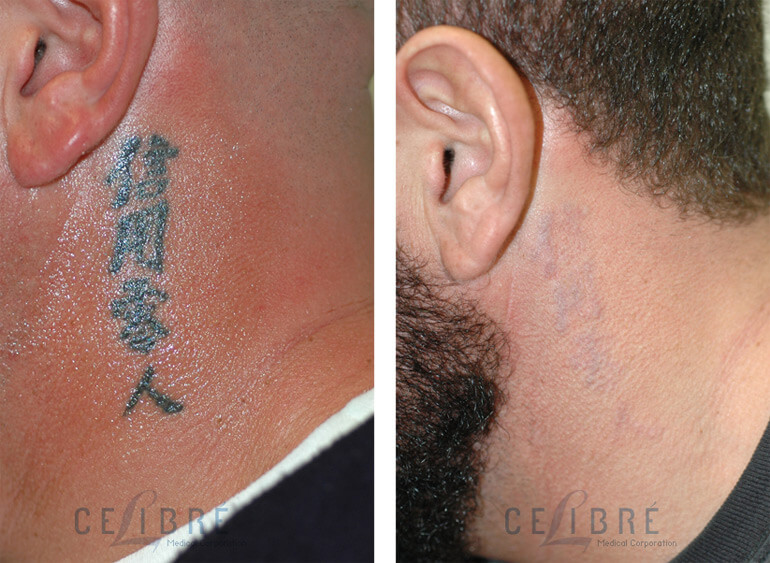
If you’re thinking about having laser resurfacing and have been doing some homework, you’ve probably come across CO2 laser resurfacing. If you’re still confused about it, it’s okay! We’re here to help you understand and make sense out of all the information out there today. Let’s start with some basic information.
What is Laser Resurfacing?
Laser resurfacing is a cosmetic treatment that can help improve the texture, elasticity and/or color of your skin. There are two forms of resurfacing: ablative and non-ablative. CO2 laser resurfacing is an ablative procedure that causes tissue injury to the surface of the skin. Essentially, we make a tiny wound that your body must heal, and this is how we stimulate your skin to make new collagen. The injury and subsequent collagen development makes new skin looks tighter, firmer and younger!
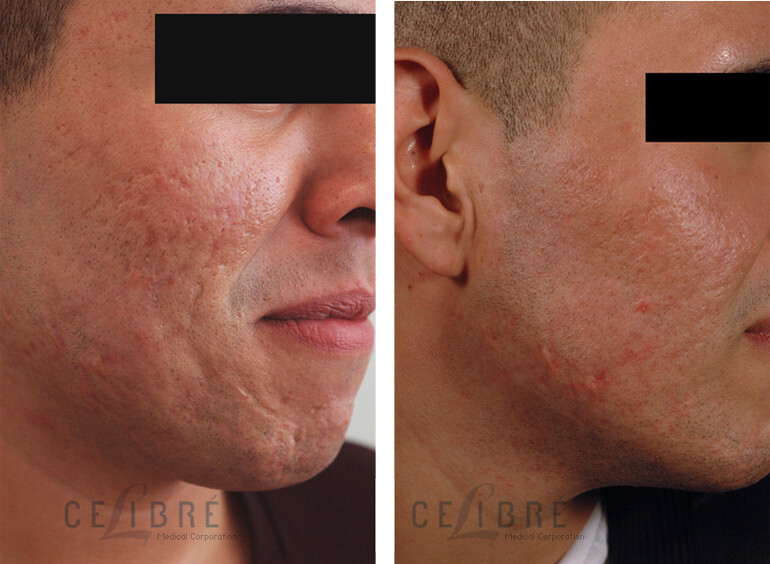
What is CO2 for?
CO2 is for Carbon Dioxide. This is the material used in the development of the laser beam used in the resurfacing procedure. CO2 lasers use light at a wavelength of 10,600 nanometers. This wavelength penetrates the skin and targets water in all of our cells. Once the light energy is absorbed into skin, it’s quickly converted into thermal energy. This heat is so intense, that the skin literally vaporizes where the laser hits it. This is why CO2 laser resurfacing is so good at producing a “controlled” wound in your skin.
What is Fractional CO2 Laser Resurfacing?
This is where it can get a bit confusing for some. Fractional CO2 laser resurfacing works in the exact same way as described above except that the beam of light energy passes through a filter (like a strainer) that splits it up into lots of smaller laser beams. Hence, fractional resurfacing removes only a portion of the treated area, usually 20% – 70%.
Older, “full field” ablative CO2 resurfacing couldn’t be done on darker skin types. Many patients suffered with infections, scarring and permanent, unwanted textural changes in their skin afterwards. Not to mention the fact that most people took at least 2 to 4 weeks to heal enough to return to work and social events. In short, the older, non-fractionated or full field resurfacing treatments were a bit of a tough sell and could only be provided to Caucasian skin types.
Fractional CO2 changed all that. The results are still impressive, but there’s much less risk of problems afterwards, and you can be fully healed usually within about a week. Newer technologies that use different energy sources such as erbium can be used on even the darkest, African American skin type (color).
Benefits of CO2 Laser Resurfacing
The benefits of CO2 laser resurfacing come about during the healing process. For example, patients with acne scars are able to improve the texture of the skin because the resurfacing procedure removes scar tissue and during the healing process, the body generates new, soft collagen that heals the skin smoother than it was prior to treatment.
What’s the Downtime for CO2 Laser Resurfacing?
This is depends on whether you have a full field or fractional treatment. Full field will require you to have a general anesthetic and typically requires several weeks of recovery. Fractional CO2 laser resurfacing can be done with a combination of local and topical anesthetic and recovery times are usually within about 5 to 7 days.
Whichever you decide is best for you, make sure that your laser practitioner has plenty of experience and walks you through step-by-step of either procedure. Being prepared and fully informed on your treatment is the best way to ensure that you are happy with your experience and results after!
At one time or another, we’ve all had “razor bumps”: those red, pimple-like, tender bumps that appear after shaving. For most of us, they’re an annoying, once-in-awhile problem. But if you suffer with constant or severe “razor bumps” then you could have a more serious condition known as pseudofolliculitis. Folliculitis in an infection and inflammation of the hair follicle. The term “pseudo” means false or artificial. That’s exactly what pseudofolliculitis is as it mimics serious medical conditions such as acne or follicle infection when it’s really just severe irritation and/or inflammation from ingrown hair due to shaving.
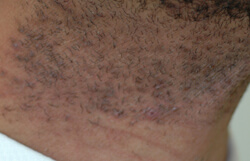
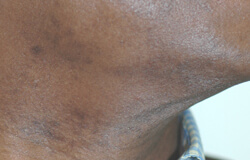
Pseudofolliculitis can affect both men and women. It’s common in people who have thick, coarse and/or curly hair, especially African Americans. Because it happens in areas where there’s hair like the face, neck, shoulders, back and bikini area, it’s commonly misdiagnosed as acne. If it’s severe, it can resemble large, acne-like cysts that can lead to deep scars, just like acne. It can also lead to embarrassing discoloration changes and textural change in the skin too.
If you have pseudofolliculitis, you know how hard it can be to keep up with shaving because it often triggers a flare up. No doubt you’ve tried multiple solutions to remove hair with little to no effect on your condition. Before you give up though, we’d like to tell you about a 100%, totally effective solution for you: laser hair removal. Laser hair removal treats this frustrating condition by getting rid of the hair that causes it in the first place. As you progress through your laser hair removal program, you will notice the razor bumps and pseudofolliculitis slowly fade and disappear.
Here at Celibre Medical, we use Class IV medical lasers to safely and effectively remove hair. We have several lasers that make it possible for us to treat unwanted hair for anyone regardless of their ethnicity and skin type (color). So, if you’ve tried (and failed) other treatments for severe, unmanageable pseudofolliculitis and want to do something that can get rid of it once and for all, then consider laser hair removal. It treats the source of the problem.
Don’t spend another day dealing with the frustrating problem of pseudofolliculitis. Get help and call us today to learn more about how Celibre Medical’s laser hair removal program can change your life!
Laser hair removal before and after pictures
We understand that if you’re shopping around for laser hair removal services, you want to make sure that you get the very best treatment for the lowest price possible. If you’ve spent some time browsing this subject on our site, then you understand there are many factors that affect the price of a laser hair removal treatment. One of those is the type of equipment or the laser hair removal device used.
You may not know there are several different, yet effective, devices out there for effective laser hair removal. The best one for you depends on your specific skin type or color. If you have a lighter skin type—like Caucasian, Hispanic or Asian, East Indian or Filipino, then the Lumenis LightSheer is an excellent choice for you.
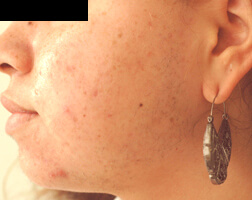

Laser hair removal before and after pictures
The Lumenis LightSheer laser has been the choice for thousands of laser hair removal practices the world over. Tens of thousands of these devices have been purchased and continue to perform as a workhorse of those who provide laser hair removal.
The reason the LightSheer works so well is that the wavelength of light it uses (810 nanometers) penetrates to the perfect depth to reach the base of the hair follicle. During treatment, the heat from the laser compromises the hair follicle’s blood supply so that it can no longer generate hair. This very particular wavelength and it’s high absorption by hair means that more energy goes into the target and very little is absorbed into other skin tissues. Not only does this make the LightSheer more effective, it makes it safer too as it reduces the risk of unwanted side effects.
We proudly offer laser hair removal services with this device at Celibre Medical. We know that this laser is not only effective, but consistent and trustworthy. For patients with an appropriate skin type, it is by far our first choice for laser hair removal anywhere on the body. We choose our devices based on performance, safety and market reputation—not simply cost. We let our patients know this because we believe it’s important for them to do the same when choosing a laser hair removal practice and practitioner.
The practice of medicine is sometimes just exactly that—a practice. While some problems have a very straightforward solution, many don’t. The practice of laser medicine is no different. At Celibre Medical, we have the laser knowledge and expertise to create an individualized laser treatment plan for you if you have an unusual problem or a routine one that hasn’t responded to conventional treatments.
One example is our use of Profractional laser resurfacing to permanently remove some types of pigmented or brown birthmarks. If you have one of these, then you may have read about treatment with q-switched lasers. Even though q-switched lasers are the gold standard for birthmark removal, we’ve had a few cases now that just didn’t respond to this approach. We’ve noted that many of these birthmarks were slightly textured. This texture keeps the light energy of the q-switched laser from penetrating the birthmark to the level of skin where it is the most effective.

Knowing what we do about the capability of the Profractional laser, we used it as treatment option with these patients. Because their only other option was a surgical excision (and surgical scar), many of them decided to give it a try. We’re happy to show you the before and after photos of one of those patients here on this page. The Sciton Profractional laser gave her a fantastic result and she was grateful to have found an option that left her without scarring.
It can be a fine line to walk—finding effective laser solutions for unwanted skin problems that don’t respond to conventional treatments. We have a team of dedicated practitioners here at Celibre who do that each and every day. We love what we do and we love to help our patients get the results they’re looking for especially when they’ve been told that they have few treatment options.
There certainly can be, but it all really depends on two things: which acne laser treatment you have and what you consider to be “downtime”. Let’s talk about what “downtime” is first.

 Downtime refers to time away from your regular work and/or school activities. Sometimes after acne laser treatments, downtime is mandatory. Following photodynamic therapy (which makes your skin light sensitive), it’s mandatory that you stay out of the sun for 2-3 days. This means that we’d ask you to be indoors for that amount of time after your acne laser procedure. More than likely, this will keep you away from your normal activities. If you need or want photodynamic therapy (or PDT), then you will need some downtime to recover. This treatment is aggressive, but it is a great option for those who need that sort of approach. After PDT, the typical amount of downtime you can expect is around five to seven days.
Downtime refers to time away from your regular work and/or school activities. Sometimes after acne laser treatments, downtime is mandatory. Following photodynamic therapy (which makes your skin light sensitive), it’s mandatory that you stay out of the sun for 2-3 days. This means that we’d ask you to be indoors for that amount of time after your acne laser procedure. More than likely, this will keep you away from your normal activities. If you need or want photodynamic therapy (or PDT), then you will need some downtime to recover. This treatment is aggressive, but it is a great option for those who need that sort of approach. After PDT, the typical amount of downtime you can expect is around five to seven days.
With other types of acne laser treatments, there is no downtime. Aramis laser treatments may cause a minor amount of redness and irritation at the time of treatment, but most patients can return directly to work. Blu-U treatments also have no downtime. If you decide one of these is right for you, then you typically can get right back to business as usual.
Acne laser treatments are varied. We offer a range of treatments that will not only help your acne get better, but that fit your lifestyle too.
At Celibre, we use a variety of Class IV dermatology lasers to treat multiple skin conditions, whereas many of our competitors rely on one laser or IPL to treat many different skin conditions. Because we treat all different skin types for approximately 15 different cosmetic skin conditions, there isn’t ONE specific laser that will work for all these situations. We’ve found that there is a “gold standard” laser for virtually every skin condition and that laser varies depending on the skin type. What we have done is to purchase the lasers that we feel are required to safely and effectively treat all skin types for all the conditions we treat. It is a decidedly customized skin care approach vs. the “one-size-fits-all” approach of our competitors.
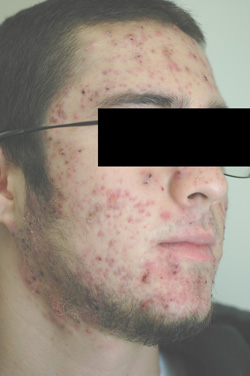
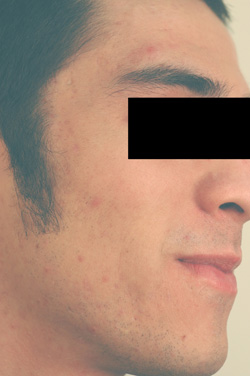 In addition to purchasing many lasers for the purpose of being able to treat all skin types for many skin conditions, we also believe having a very strong laser portfolio helps us achieve better outcomes by combining different types of lasers into the same skin care plan. In our experience and with the support of research, combining more than one wavelength (or laser) is ideal for achieving optimal results for many different skin conditions. For example, one laser may best address pigmentation related to acne scars while another laser is ideal for targeting the sebaceous glands. Combining a third laser that has a photo-acoustic affect that kills acne bacteria. Together, these lasers are much more effective than without each other.
In addition to purchasing many lasers for the purpose of being able to treat all skin types for many skin conditions, we also believe having a very strong laser portfolio helps us achieve better outcomes by combining different types of lasers into the same skin care plan. In our experience and with the support of research, combining more than one wavelength (or laser) is ideal for achieving optimal results for many different skin conditions. For example, one laser may best address pigmentation related to acne scars while another laser is ideal for targeting the sebaceous glands. Combining a third laser that has a photo-acoustic affect that kills acne bacteria. Together, these lasers are much more effective than without each other.
By having multiple lasers, we are able to tailor the right “recipe” for each patient as it relates to their skin condition, goals, and skin type. In the same manner that one medication cannot treat all people, one laser or skin care plan should not be used for every patient.
Brown spots or sun spots can be found anywhere on the body. Although common on the face, it is not too unusual to find them on the lips as well. For some patients, this represents a cosmetic concern because they are not easily covered. Sun spots on the lips are effectively treated with Q-switched lasers. At Celibre, we use Q-switched Yag lasers to resolve these lesions in as little as 1 to 3 treatments performed every 4 weeks. There is very little discomfort and most treatments are completed in fifteen minutes. Treatments are safe for all skin types.
Sun Spot Removal Free Consultations
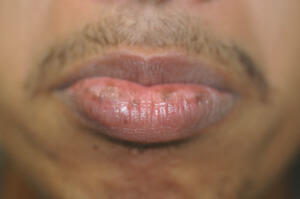

Sun Spot Removal Before and After Pictures
When protecting your face with sunscreen, don’t forget the lips. Lip balms that provide SPF are a good source of protection.
Lori Haney, RN, MEP-C
Certified Medical Laser Safety Officer
If you’ve been researching the most effective anti-aging procedures available today, then you’ve probably come across laser resurfacing. While there are many different lasers available, Profractional and Fraxel are two of the most popular. What you may not realize is that “Fraxel” treatments can be very different from treatment to treatment. At Celibre Medical, we have talked to many “Fraxel” patients who’ve been disappointed with their results. You may have noticed a similar trend while reading online reviews online. Or maybe you’ve had laser resurfacing and have been unhappy with the minimal improvement it produced.
Here’s why: while Profractional laser resurfacing can be extremely effective for acne scars, wrinkles, and loose skin, it’s a procedure that needs to be done deeply to see the very best results. When we inquire about the recovery of unhappy Fraxel patients from other medical practices, many tell us that they simply had a topical anesthetic (or numbing cream) prior to their procedure. They also tell us that they had little to no bleeding after the procedure. This also clues us in that their resurfacing procedure was very superficial, meaning that only the top few layer of skin was treated.
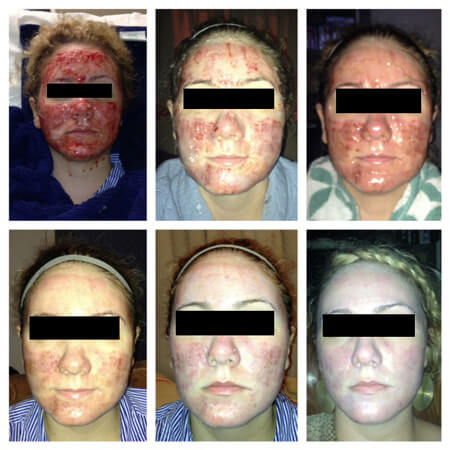
For a laser resurfacing procedure to produce dramatic results, it simply has to be a deeper. Not to say that lighter resurfacing doesn’t have a place in our industry, but you can’t get dramatic results from a single light laser resurfacing procedure.
What’s involved with more aggressive Profractional resurfacing? First, you will need more than topical numbing. We use topical numbing creams, but also prescribe Valium and/or Tramadol for the procedure to make it more comfortable. In other cases, because the laser penetrates deeply into the dermal (middle) skin layer, dental blocks with lidocaine are necessary as well. Without proper anesthesia, deeper, aggressive laser resurfacing procedures are not tolerable because they are extremely painful.
Bleeding also tells us a lot about what level of skin was treated. The deeper into the dermis, the more bleeding you will have during the treatment. Remember, in order to get significant collagen remodeling and stimulation to correct acne scarring and moderate to severe skin wrinkling, you need the level of injury to be in the dermis. Superficial laser resurfacing just won’t get down to this level. Unhappy patients from other practices often tell us that they had no bleeding.
Take a look at one of our patient’s photos taken daily for seven days following a deep resurfacing procedure for the treatment of acne scars. If these seem nothing like the recovery process that you had following a laser resurfacing treatment that you were disappointed with, then it’s probably because it wasn’t as deep as you needed to get what you wanted out of it.
While it may seem drastic, our patients tell us that the process was worth it and easy to live through because we took the time to discuss it with them and prepare them for their recovery ahead of time. They also tell us that their results are totally worth it!
Because there are many types of <strong”>acne scars there is no single laser that can help with all of them. Three types of lasers used to improve or eliminate acne scars include the CO2/Erbium (for textured acne scars), pulse dye (for red acne scars) and q-switched (for pigmented acne scars).
Erbium/CO2 laser resurfacing is a commonly used treatment for textured <strong”>acne scars. The Erbium and CO2 lasers are designed to resurface the skin by removing the outermost layers or in the case of fractional resurfacing by making small perforations in the skin that remove scar tissue. When the skin regenerates, it develops new collagen that replaces hard, fibrous scar tissue and in the process smooths the texture of the skin. The skin appears smoother and more pliable with a reduced depth and softer edges. Although it is difficult to get rid of textured acne scars altogether, they can be greatly improved with CO2 and Erbium lasers. With several laser resurfacing treatments, textured acne scars can be improved between 25% and 75% on average. Improvement depends on depth of scars, age of scars, age of the patient and the number of treatments.
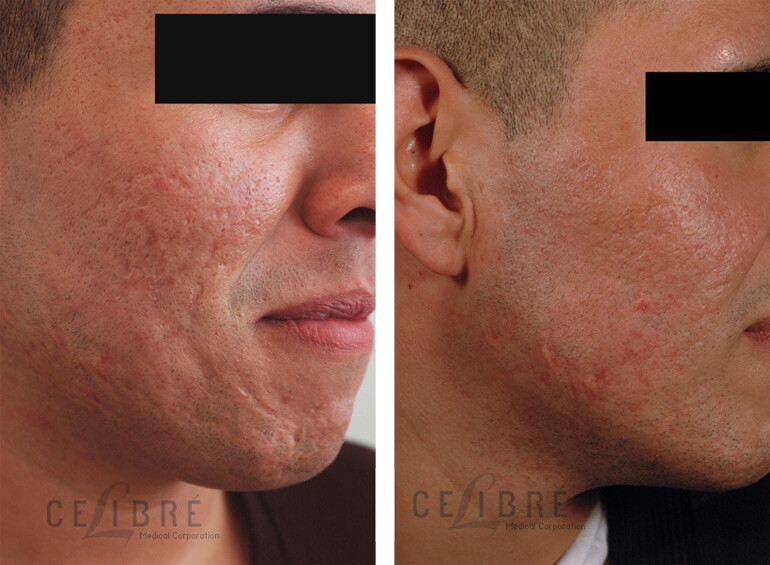
Pigmented acne scars are treated with different lasers based on their color. In lighter skinned individuals, pigmented acne scars are usually red. They are created by a healing response that brings small blood vessels to the site of the injury. In darker skinned individuals, this same healing response leads to darker acne marks by bringing melanin (the body’s natural pigment) to the site of the injury. Using heat generated by pulsed dye and q-switched lasers, we are able to eliminate the redness or darkness associated with the two types of colored acne scars. The pulse dye laser is attracted to hemoglobin in blood. When used to treat red acne scars, it closes the small blood vessels developed during the healing response, thereby decreasing the redness. In the case of dark skinned individuals, the q-switched laser heats up the melanin (temporary post inflammatory hyper-pigmentation or PIH) that was brought to the site during the healing process. The heat energy of the laser breaks down this excess pigment and allows it to be carried away from the site of the acne lesion, which reduces the appearance of the mark.
Besides laser treatments, there are several other options for acne scar treatments, including subcision with dermal filler injections, punch excision and dermabrasion (not microdermabrasion).
Rosacea is a common, frustrating skin condition affects millions of Americans. While many patients may find relief with prescription medications, many do not. If you’re searching for alternatives to medication, treatment with a pulsed-dye laser can offer you a safe and effective alternative to medications. However, Rosacea is not curable. Laser treatment can calm it and help your skin look more normal, but you will need to have regular maintenance treatments to keep your skin looking its very best.
Pulsed dye lasers target the excessive facial blood vessels associated with Rosacea. Excessive blood vessels are why your skin appears pink or red and why you blush or flush easily. Pulsed dye lasers can safely improve Rosacea, and these work better to clear the redness, but treatments may also leave your skin slightly bruised . We tell our patients that aggressive pulsed dye laser treatments will usually require them to have several days of “social downtime”. This means you stay away from work, school or social activities while the bruises fade.

Rosacea laser treatment before and after pictures
An important factor in aggressive pulsed dye laser treatments for rosacea is your skin type. These types of treatments are normally used with lighter skin types. Darker skin types have an increased risk of unwanted side effects with aggressive pulsed dye laser treatments, so we use them cautiously.
Appropriate Rosacea patients who choose aggressive laser treatments can expect to see dramatic improvement in the appearance of their skin in 3-4 treatments spaced 4 weeks apart. For patients who need or choose normal (non-aggressive) pulsed dye laser treatments, they can expect improvement after 4-6 sessions spaced 4 weeks apart.
Celibre Medical has the laser expertise, equipment and knowledge you’re looking for if you’ve failed other Rosacea treatments and are looking for a safe, effective Rosacea treatment option. We can design and execute a Rosacea laser treatment program that perfectly fits your needs, goals, budget and lifestyle.
Can I get laser treatment if I have dark skin? The answer to the question is absolutely you can have laser treatments if you have medium or dark skin. We’ve heard so many times from patients with olive (Asian, Hispanic) or darker (African American) skin that a medical office told them they could not have laser treatments because of their skin type. Perhaps that patient may not be able to have laser treatments with that practitioner, but, at Celibre, we’ve been successfully treating darker skin types with lasers since 2004.
How are we able to treat darker skin with lasers when others cannot?
There are two key issues when it comes to treating dark skin and why many practices will tell you it can’t be done. The first is experience. Because our office is in Los Angeles (Torrance), we see ALL skin types all the time. In addition, we treat a wide variety of skin conditions includingage spots, wrinkles, excess hair, acne scars and birthmarks. These skin concerns are not limited to lighter skin types so treating them for all skin types for over 20 years has given us a depth of knowledge unmatched in our area.
Technology matters. At Celibre, we have over 20 different lasers because we offer many different treatments for many different skin conditions. The wide variety of skin types combined with the broad service offering means that we have a lot of laser technology to support our efforts. While anyone can turn on a laser and fire it, experience and skills will determine if you get the right outcome, or worse if you have a serious side effect. Our broad array of laser technology combined with decades of laser experience mean that, regardless of your skin type, we can help with your concern.
What is my skin type?
In our industry, there is a measure of the tone of your skin and it’s called the Fitzpatrick skin typing scale. The scale goes from skin type 1-6, and generally speaking, follows the outline below.
Skin type 1: Caucasian – light Northern European
Skin type 2: Caucasian – European
Skin type 3: Caucasian – Mediterranean, Eastern European, Italian, Greek
Skin type 4: Asian, Hispanic, East Indian, Light African American mixes
Skin type 5: African American
Skin type 6: Dark African
Your skin type (or color) is very important in determining which lasers are appropriate for you and can dictate which treatments are available. Your skin type is determined by evaluating the amount and density of melanin (pigment). During the consultation, we will often ask questions about your skin’s behavior in the sun, ethnicity or race, and your response to previous laser treatments. This helps us determine what skin type (color) you are as the answer is not always clear cut.
What lasers are most appropriate for dark skin?
If you have dark skin, there are many lasers and treatments that are safe for you. Generally, devices that use a longer wavelength of light are
considered safe or safer for dark skin. The most common laser you willhear about (not brand but type) is the “Yag” laser for African American
skin. Yag lasers (1064 nanometer invisible light) are used extensively inour practice for laser hair removal, tattoo removal, acne scars, birthmarks, sunspots, spider veins, fine lines and wrinkles, pore size andmore. Because the light is not visible to the naked eye, it can pass
through the melanin contained in the outer layer of skin to affect thetarget tissue below.
Can laser resurfacing be used for dark skin?
Yes. The challenge is that most practices use CO2 for their resurfacing. AtCelibre, we use Erbium lasers for our resurfacing procedure as there is much less risk of side effects than with CO2. In the before and afterphotos, you skin see all skin types treated with our erbium lasers for conditions like wrinkles and acne scars, the most common condition associated with laser resurfacing.
Can I get laser treatment if I am Hispanic, Asian or Black?
Yes to all three and also if you are South American, Central American, EastIndian, Pakistani, Persian, Japanese, Chinese, Vietnamese, Thai, Filipino, American Indian, etc. Etc. To reiterate, because we have the broad suite of laser technology and the decades of experience we do, treating all skin types with lasers is possible.
What are possible side effects from treating dark skin with lasers?
All lasers have the potential to create side effects for any skin type. So, while the risk of a side effect may be higher with certain lasers for darkerskin types, it’s lower for certain lasers as well. For example, the Nd:Yg(Yag) laser reference above is extremely safe for dark skin, including very dark African skin. The reason being that it is invisible light. For other types of lasers, the risk is a lot higher for darker skin types and this is where experience comes in. Treating sunspots in a mixed (½ black, ½white) patient can be extremely difficult. But we have done it successfully for many years.
What about IPL for dark skin?
It’s confusing to consumers, but IPL (which stands for Intense Pulsed Light) is not laser technology. Lasers are more powerful, but more importantly, more precise in their targeting of parts of the skin such asindividual hairs or spider veins. For this reason, IPL has a higher risk of side effects with darker skin, and we do not use it as often as our lasers. Also, because most IPL machines use a large spot size, it is difficult to treat something like a small pea sized age spot. The treatment ends upcovering too much area which can contribute to side effects. With our lasers, we have spot sizes as small as 1 millimeter.
At Celibre Medical, we’re experts at using more than 20 different lasers to achieve excellent results for patients with all skin types (colors). If you’re not sure if your skin type is appropriate for a particular treatment, we encourage you to call or visit us for a consultation and ask questions about our experience with similar treatments and your particular skin type. Give us a call today to learn more.
Most patients like you with unwanted tattoos are interested in the idea of laser tattoo removal, but are not sure how it works. Before we get too far into the science of tattoo removal, it’s important to understand that it is a very specific and intentional process—much like getting a tattoo in the first place. Lasers designed for tattoo removal use short but extremely powerful bursts of light that specifically target the ink particles of the tattoo without harming (too much) the surrounding skin. This process of preferential absorption into the tattoo ink is known in the laser world as “selective photothermolysis”.
So, how does the process work? The answer lies within the tattoo – a lot of implanted ink. As you might remember when you got your tattoo, your artist used a needle to “push” the ink into the deeper layer of your skin, known as your dermis. These ink particles were likely layered on top of one another to create the image of your tattoo. Normally, your immune system works to remove foreign things like viruses and bacteria. It tries hard to do the same with the ink particles in your tattoo, but they are just too large, so your tattoo remains visible on your skin permanently.
Tattoo removal lasers don’t actually remove the tattoo—they simply break up the ink particles into small enough pieces so that your body can do the removal naturally on its own. This explains why it’s not a single treatment process and why it takes several treatments for optimal tattoo removal.
Not every laser works for tattoo removal. Specifically, a type of laser known as a “q-switched” is best for these treatments. Q-switching is not a specific wavelength of light, but rather a way that light is amplified and made more powerful by the laser. Q-switched lasers utilize different wavelengths of light—which is helpful since different colors of tattoo ink attract different wavelengths.
Laser tattoo removal is a process that is customized for each patient. No two tattoos are exactly alike and neither are two laser tattoo removal programs. Sometimes, what worked for one patient’s tattoo won’t for another, and some tattoos take longer to treat than others and require the use of several different q-switched devices rather than just one.
Most laser tattoo removal can be successfully completed with a series of 5 to 15 treatments spaced 6 to 8 weeks apart. If you have a lot of color in your tattoo, you will likely be on the higher end of this estimate. Dark colors absorb light easily, and are the easiest colors to remove. Dark blue and black respond quickest and red is the next easiest to remove after the dark colors. Other colors including pink, green, light blue, orange and white are more difficult to treat because they don’t absorb light easily. These colors can often take several visits to remove or can require a different type of laser altogether to remove them.

* Tattoo Removal Before and After Photos
Living with an unwanted scar is difficult. It may remind you daily of trauma or an injury that you’d rather forget. The treatment of unwanted scars is varied and can be complex because each scar has its own characteristics. There is no one-size-fits-all approach. Finding a practice with the skill and range of technology to treat scars can be challenging.

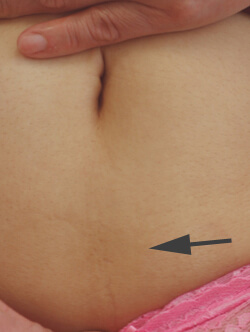 At Celibre Medical, we offer a range of treatments for scar removal. One of these is laser treatment. We have lasers that can target the individual characteristics of your scar including: redness, brown discoloration, or textural changes such thickness or depression (atrophy). Because the gamut of possible treatments is so broad, it’s hard to answer the question of how many laser treatments are necessary.
At Celibre Medical, we offer a range of treatments for scar removal. One of these is laser treatment. We have lasers that can target the individual characteristics of your scar including: redness, brown discoloration, or textural changes such thickness or depression (atrophy). Because the gamut of possible treatments is so broad, it’s hard to answer the question of how many laser treatments are necessary.
In general, we counsel our patients that most will see improvement within three laser treatments. These are spaced about four weeks apart. This is also the minimum number of treatments we’d recommend because it is usually at this point that we can tell if we’re going in the right direction with your treatments or if we need to develop a revised treatment plan.
It’s important to mention that we will never promise complete removal of a scar. Our approach is to evaluate your scar(s) fully, build a treatment plan that we think will work best for you, and then tell you that despite our best efforts, we may not be able to achieve your goals.
Laser scar removal before and after pictures
Contact us today to schedule a FREE consultation! 
You may have research the type of laser treatments you want to have, and are all set to book your first appointment. But do you know who will be holding that laser to your skin? Do you understand his or her training, education and qualifications? Many consumers take so much time focused on the type of laser that they neglect to focus on finding the right laser practitioner. Experience matters in laser dermatology.
So who can perform laser treatments? Each state has its own regulating body that dictates who may perform them. The explosive growth of the laser industry and demand for laser treatments has made it hard for regulatory agencies to keep up legislative guidelines as to who can provide laser treatments.
Some states have no regulation about who can operate a high-powered medical laser, while others are very restrictive allowing only licensed physicians to perform laser procedures. Here in California, there is a balanced approach: licensed physicians, registered nurses, nurse practitioners and physician assistants may all perform these treatments. However, a licensed physician must oversee a practice in which non-physician providers are operating lasers.
At Celibre Medical, we take this one step further. Our facility serves as a laser training site and provides continuing medical education credits for the California Board of Registered Nursing.
There has never been a more critical time in our industry for the medical community to be proactive in shaping, defining and abiding by the state regulations on laser medicine that are designed to protect you, the consumer. Celibre is proud to set a high standard for excellence in laser safety and patient-centered care.
If you’re looking for a laser practitioner in the Los Angeles or torrance area, we advise you to be vigilant and do your homework. Ensure that your laser practitioner is a licensed medical professional practicing within the legal bounds of their scope of practice. Make sure they have the proper training and experience with the laser, and ask questions about their background, education and track record with the device that you’re considering. Do several consultations to get a feel for the practice and practitioner that’s right for you.

